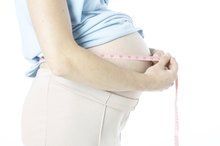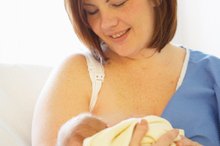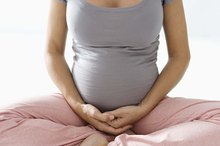Abdominal Pain While Nursing
The physical and emotional feelings that arise from childbirth can be exhilarating and exhausting. Many women report a feeling of not fully “owning” or being in control of their bodies, especially in the immediate postpartum period 1. Shifting hormones and new physical changes start rapidly in preparation for lactation and returning a woman’s body to its pre-pregnant state. Various aches and pains typically occur as a normal part of these processes.
If you are experiencing serious medical symptoms, seek emergency treatment immediately.
Postpartum Changes of the Uterus
As Merck.com describes, the process of uterine involution is progressive. After childbirth, a woman’s uterus steadily returns to its pre-pregnant shape and size by way of uterine contractions. This process begins immediately after birth and continues for about four to six weeks, at which point the uterus has most often returned to its pre-pregnant state. One to two weeks after delivery, the upper margin of the average uterus can still be felt between the pubic bone and the belly button.
- As Merck.com describes, the process of uterine involution is progressive.
- One to two weeks after delivery, the upper margin of the average uterus can still be felt between the pubic bone and the belly button.
After Pains
A Swollen Vagina After a C-Section
Learn More
Uterine contractions occurring after delivery are often called “after pains.” After pains can range from mild to severe. Pain perception is complex; individual tolerance and physical factors both influence discomfort. Breastfeeding often exacerbates after pains. The hormone oxytocin, which is released during breastfeeding, also causes uterine contractions. Breastfeeding thus has the added benefit of enhancing proper recovery of the uterus. However, exaggerated uterine contractions can be quite uncomfortable and difficult to cope with. Many first-time mothers barely notice after pains, as uterine muscles are stronger from not having been stretched before. Subsequent deliveries typically result in stronger after pains as the increasingly stretched uterus has to contract harder to regain its shape.
- Uterine contractions occurring after delivery are often called “after pains.” Subsequent deliveries typically result in stronger after pains as the increasingly stretched uterus has to contract harder to regain its shape.
Postoperative Incision Pain
Another possible cause of abdominal pain during breastfeeding during the early period after delivery is postoperative incision pain. Women who have undergone a cesarean section experience after pains as well as discomfort from the incision. Mymidwife.org says discomfort from the internal part of a cesarean incision can last longer than six weeks, often for a full two months. Sometimes during breastfeeding, it is hard for women in this situation to know which hurts more. In addition, if a baby is breastfeeding in a position that puts pressure on the incision, abdominal pain can result. This is easily remedied by changing positions to avoid doing so.
- Another possible cause of abdominal pain during breastfeeding during the early period after delivery is postoperative incision pain.
- In addition, if a baby is breastfeeding in a position that puts pressure on the incision, abdominal pain can result.
A Full Bladder
What Are the Causes of an Enlarged Uterus?
Learn More
After childbirth, the presence of a full bladder can displace the still-enlarged uterus, aggravating after pains during breastfeeding and in general. Even in the absence of noticeable after pains, a full bladder can exacerbate incision pain from a cesarean section by the same mechanism.
Tips
It is important to stay well-hydrated while breastfeeding and to remember to empty the bladder regularly to avoid adding to discomfort from uterine contractions and incision pain while nursing. Taking acetaminophen or ibuprofen before breastfeeding can often help alleviate after pains felt during breastfeeding; ask your doctor if this is appropriate for you before taking any medicine. After delivery and especially for the first week or two, try to avoid breastfeeding in a position that adds pressure to the site of a cesarean section incision. Nursing pillows placed on or near the incision can also be irritating, so be mindful of where these are placed.
- It is important to stay well-hydrated while breastfeeding and to remember to empty the bladder regularly to avoid adding to discomfort from uterine contractions and incision pain while nursing.
Cautions
It is not typical for uterine contractions to cause pain during breastfeeding after the first six weeks have passed post-delivery. Many factors can potentially cause abdominal pain, some harmless and others of concern. Because of the subjective nature of pain and the number of possible causes, it is important to let your doctor know each time you experience unexplained abdominal pain. Abdominal pain accompanied by fever, nausea, vomiting, diarrhea, vaginal bleeding or other unusual symptoms may be an emergency and should be addressed by a doctor right away.
- It is not typical for uterine contractions to cause pain during breastfeeding after the first six weeks have passed post-delivery.
- Because of the subjective nature of pain and the number of possible causes, it is important to let your doctor know each time you experience unexplained abdominal pain.
Related Articles
References
Resources
Writer Bio
Based in Princeton, N.J., Elizabeth Moore has written health-related patient education materials since 1992. She is a registered nurse with more than 15 years of clinical experience. Moore earned an Associate of Applied Science in nursing from Phillips Beth Israel School of Nursing.









